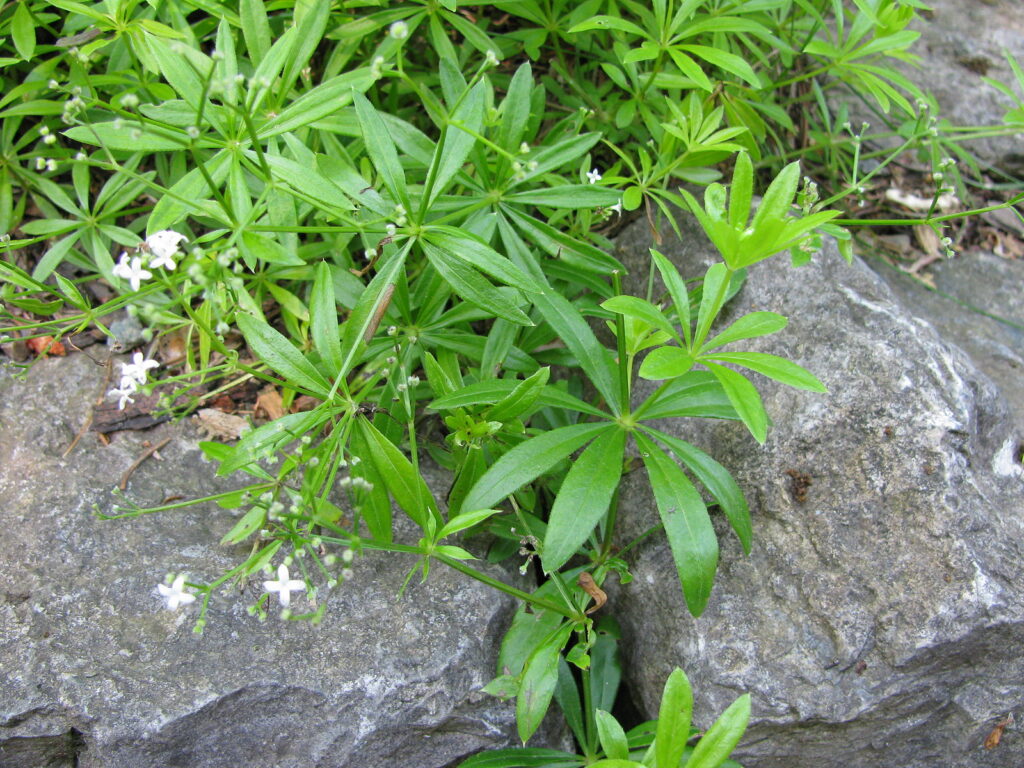Galium — commonly called sweet woodruff– is a carpet-like, spreading perennial with emerald-green leaves and a froth of starry white blooms that appear from late spring to midsummer.
Sweet woodruff is a good choice for a shade or woodland garden. It can tolerate dry soil under a large tree. Galium will grow in just about any soil as long as it gets a bit of moisture and is shaded from the hot midday sun.
The Galium genus consists of about 400 species of annuals and perennials found mainly in meadows and woodlands in temperate regions.

Get to know Galium
- Plant type: Perennial
- Growing Zones and range: Zones 4 to 8
- Hardiness: Hardy to Zone 4
- Height and width: 4 to 12 inches tall (10-30cm); 12 inches (30cm) wide
- Foliage: Slender, square stems 6 to 12 inches high, encircled every inch or so by whorls of 6 to 8 aromatic, bristle-tipped leaves.
- Flowers: Clusters of tiny white, pinkish, or yellow tubular flowers appear above the foliage
- Bloom time: Late spring and summer
- Uses: Groundcover, along walkways, beneath shade trees, and in woodland gardens; Galium attracts bees
- Common name: Sweet woodruff
- Botanical name: Galium odoratum (Asperula odorata)
- Family: Rubiaceae
Where to plant Galium
- Grow Galium in full sun or partial shade. Plant in partial shade in hot climates.
- Plant Galiumin humus-rich, well-drained, acidic soil. Add peat moss or composted leaves around plants.

When to plant Galium
- Set outdoors Galium in the garden in spring.
- Set rhizomes in the garden in autumn or spring.
Planting and spacing Galium
- Space Galium plants 12 inches (30cm) apart.
- Set rhizomes about an inch (2.5cm) below the soil.
- Sow seed in evenly prepared soil.
How to water and feed Galium
- Keep the soil evenly moist.
- Spread aged compost around Galium to add nutrients to the soil.
Galium care
- Galium prefers slightly acidic soil; increase soil acidity by adding peat moss, composted oak leaves, or pine straw mulch.
- Galium will spread rapidly in rich soil with abundant moisture; it can become invasive if left entirely unchecked.
Galium pests and diseases
- Galium is prone to downy mildew, powdery mildew, rust, and a variety of fungal leaf spots.
Galium propagation
- Sow seeds in containers in a cold frame as soon as ripe.
- Separate rhizomes in autumn or early spring and replant.
Galium varieties to grow
- Galium odoratum, sweet woodruff, ladies’ bedstraw: Fast spreading in moist, shady sites but easy to control; tiny star-shaped white flowers; leaves are bright green at first, then become olive green or take on yellow overtones through the season.















